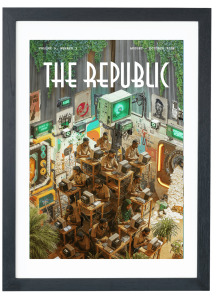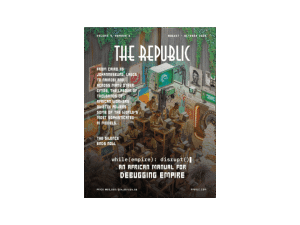
Photo illustration by Dami Mojid / THE REPUBLIC. Source Ref: Abdoulaye Wade. MARCEL BIERI / WORLD ECONOMIC FORUM.
THE MINISTRY OF business x the economy
Is China’s Belt and Road Initiative in Africa a Development Catalyst or Debt Trap?

Photo illustration by Dami Mojid / THE REPUBLIC. Source Ref: Abdoulaye Wade. MARCEL BIERI / WORLD ECONOMIC FORUM.
THE MINISTRY OF business x the economy
Is China’s Belt and Road Initiative in Africa a Development Catalyst or Debt Trap?
Within half a century, China has undergone major economic transformation, emerging as a key player in global finance and infrastructure development. At the heart of China’s expanding global influence is the Belt and Road Initiative (BRI)¾one of the most ambitious infrastructure projects in modern history. Launched in 2013, the BRI was originally envisioned as a revival of ancient trade routes. However, it has since evolved into a vast geopolitical and economic endeavour, involving over 150 countries and spanning trillions of dollars.
Yet, the initiative is having mixed reactions. Nowhere is this debate over the impact of Chinese lending and infrastructure development more pronounced than in Africa, where Chinese investments have become a defining feature of the continent’s financial landscape. This debate is not just theoretical, it carries profound implications for the continent’s economic future.
As Africa deepens its engagement with the BRI, a critical question emerges: is the BRI fostering sustainable economic development, or is it exacerbating fiscal vulnerabilities through unsustainable debt? Recent geopolitical developments, including the recalibration of the United States’ foreign policy under President Donald Trump, the erosion of traditional alliances and weakening multilateral frameworks, may amplify China’s strategic position in Africa. As African nations navigate these evolving dynamics, it is more important now more than ever to critically assess the long-term implications of the BRI.
BRIDGING THE GAP: HOW THE BRI ADDRESSES AFRICA’S INFRASTRUCTURE DEFICIT AND FINANCING CHALLENGES
The African Development Bank has emphasized Africa’s massive infrastructure deficit and the need to fill this gap. A 2023 study published by the Observer Research Foundation highlights the role of the BRI in helping to bridge Africa’s infrastructure deficit, describing it as offering a ‘lucrative economic investment package, flexible political approach, and focused big-ticket development projects.’ It is this combination, particularly the flexibility in political approach and the emphasis on large-scale infrastructure that has made the BRI attractive for many African countries. In fact, by February 2025, 53 African countries had signed a BRI memoranda of understanding with China, signalling a strong interest to participate in ambitious infrastructural projects with limited policy interference. This contrasts with traditional Western financing, which often comes with stringent conditions relating to governance, human rights and macroeconomic stability. Thus, China’s model presents itself as less intrusive, faster to execute and closely aligned with Africa’s urgent infrastructure needs.
China’s approach under the BRI is framed by five central objectives: policy coordination, facilities connectivity, unimpeded trade, financial integration and people-to-people bonds. The rapid deployment of funds and projects under the BRI is seen as more responsive and marks a departure from the traditional Western-led financial institutions such as the World Bank and the International Monetary Fund. The perception of China as a more responsive and effective development partner is not new. The former president of Senegal, Abdoulaye Wade, captured this sentiment in a 2008 Financial Times op-ed, when he remarked that:
China’s approach to our needs is simply better adapted than the slow and sometimes patronizing post-colonial approach of European investors, donor organizations and non-governmental organizations […]. With direct aid, credit lines and reasonable contracts, China has helped African nations build infrastructure projects in record time—bridges, roads, schools, hospitals, dams, legislative buildings, stadiums and airports. […] I have found that a contract that would take five years to discuss, negotiate and sign with the World Bank takes three months when we have dealt with Chinese authorities. I am a firm believer in good governance and the rule of law. But when bureaucracy and senseless red tape impede our ability to act—and when poverty persists while international functionaries drag their feet— African leaders have an obligation to opt for swifter solutions.
Wade’s statement echoed the frustrations many African countries have with traditional development finance, where bureaucratic delays and onerous conditions can stifle progress. To reflect the shift away from Western-led financing, China is now estimated to have approximately 2.5 times more in African infrastructure development than all Western countries combined. This surge in Chinese investment has spurred a variety of flagship projects across the continent. Notable examples include the Standard Gauge Rail (SGR) project in Kenya and the Addis–Djibouti Railway in Ethiopia, both of which promised to revolutionize connectivity and increase trade in the East African region.
For Kenya, the SGR, a $5 billion infrastructure project financed by the Chinese state-owned Export–Import Bank of China, stands as one of the most significant investments in the country since its independence. The railway connects Nairobi, the capital, to Mombasa, the country’s main port city, reducing commuting from ten hours to just four hours. However, the project’s long-term success remains contingent on extending the railway to neighbouring Uganda and Rwanda, which is yet to materialize due to financial constraints and challenges with servicing BRI debts. The project has faced criticisms for corruption and environmental concerns, as the route cuts through a wildlife park. With Kenya owing China more than $8 billion in BRI-related debts, President William Ruto has requested $1 billion in loan restructuring to help address stalled projects and alleviate the financial burden.
In Ethiopia, the Addis Ababa–Djibouti Railway, an electronic railway funded and built by Chinese companies, aims at enhancing regional trade by linking landlocked Ethiopia to the Port of Djibouti—where China has significant stakes, including a naval base. The project aims to modernize 750 kilometres of railway networks with a total cost of $4 billion. In 2019, the initial loan of $1.3 billion was disbursed, and it featured a three per cent interest rate and a six-year repayment term.
Beyond these projects, a September 2019 Brookings Institute report highlights several other significant loans extended to African countries for large-scale infrastructure under terms varying in duration, grace periods and interest rates. Among these, in December 2011, Uganda borrowed $350 million for the Entebbe-Kampala Expressway under a 20-year term, with a seven-year grace period and a fixed two per cent interest rate. Additionally, in December 2014 and February 2015, Uganda secured two loans amounting to approximately $1.4 billion to finance the Karuma hydropower station, with a repayment term of 20 years, a five-year grace period and a fixed two per cent interest rate.
In January 2013, Cameroon concluded a loan agreement for approximately $541 million for Phase I and $141 million in February 2017 for Phase II of the 211 MW Memve’ele Hydropower project. Meanwhile, in 2012, Nigeria took on a $500 million loan for Phase I of the Abuja-Masaka Light Rail project, with a 20-year term, a seven-year grace period and a fixed interest rate of 2.5 per cent. These loans underscore the significant role that Chinese financing plays in Africa’s infrastructure development.
shop the republic
-
‘The Empire Hacks Back’ by Olalekan Jeyifous by Olalekan Jeyifous
₦70,000.00 – ₦75,000.00Price range: ₦70,000.00 through ₦75,000.00 -
‘Make the World Burn Again’ by Edel Rodriguez by Edel Rodriguez
₦70,000.00 – ₦75,000.00Price range: ₦70,000.00 through ₦75,000.00 -
‘Nigerian Theatre’ Print by Shalom Ojo
₦150,000.00 -
‘Natural Synthesis’ Print by Diana Ejaita
₦70,000.00 – ₦75,000.00Price range: ₦70,000.00 through ₦75,000.00
WHAT AFRICA’S DEBT BURDEN REVEALS ABOUT THE BRI
Beneath the surface of the gleaming railways and highways that form part of the BRI, questions still arise with respect to debt sustainability, sovereignty and economic dependency. The question is not whether the BRI is reshaping the continent’s infrastructure landscape¾it definitely is¾but rather, how these projects will impact the long-term development of the countries involved. In this context, China’s growing presence in Africa raises questions about the impacts of its geopolitical influence and concerns on the risks of financial dependency, which could potentially trap African countries in a perpetual debt cycle.
There are concerns about the economic impacts of these loans, including the impacts on the debt burdens of recipient countries. For instance, large scale infrastructure projects in the transport sector, that may be justified on the grounds of enhancing connectivity, have raised questions on whether they actually justify the level of debt they result in. A case in point is the question of whether the loan to construct the Entebbe-Kampala expressway to connect the Ugandan capital and the main international airport truly generated enough economic transformation and long-term gains to justify the close to $500 million cost. The Entebbe-Kampala expressway has also been criticized for its high construction cost, making it one of the most expensive roads per kilometre in the world. The future repayments of these loans are uncertain, with Uganda’s ability to generate significant toll revenue from the expressway in question.
The mounting debt burden of African countries involved in the BRI raises significant concerns about the long-term sustainability of this model, especially when projects fail to meet their revenue targets. As the debt levels of African countries grow, Chinese lending is becoming an important feature of Africa’s increasing debt-to-GDP ratios. Thus, there is a need for strategic project selection and better project feasibility assessments, better debt management and more debt transparency. Linked to the question of the debt impacts of the loans are concerns about undisclosed debt and hidden public debt exposure, such as those arising from projects structured as public-private partnerships, like the Build, Operate and Transfer model that is commonly used.
shop the republic
Africa is facing a mounting debt crisis, with many countries struggling under the weight of external loans, rising interest rates and limited fiscal space for development. China is now Africa’s largest bilateral lender and its approach to infrastructure development has differed to the approach of multilateral lenders like the World Bank and Paris Club lenders. Unlike traditional concessional financing from multilateral institutions and countries, which often comes with stricter governance and transparency conditions, Chinese BRI loans have been criticized for their opaque terms. This has resulted in fears that the loans are collateralized by strategic assets and used as tools of ‘debt-trap diplomacy’. Debt-trap diplomacy is a concept coined by Indian academic, Brahma Chellaney, in 2017 to describe China’s BRI as a strategy that involves extending excessive loans to developing countries who are already heavily indebted, with the intent of compelling them to cede strategic assets or offer political concessions to alleviate their debt burden.
While some, such as Lee Jones and Shahar Hameiri in an August 2020 research paper published by Chatham House, believe that there is limited evidence to support the notion of a ‘debt trap diplomacy’ in the context of the BRI in Africa, other studies, such as the 2024 article by Vali Kaleji acknowledge the use of this strategy. Irrespective of the differing views on whether China is employing debt trap diplomacy as a strategy in Africa, what remains evident is that opaqueness poses a major challenge, as the lack of transparency with loan agreements makes it difficult to fully assess the risks involved. This point has been emphasized by Deborah Brautigam whose 2019 research, ‘A Critical Look at Chinese “Debt-Trap Diplomacy”: The Rise of a Meme’, critiques the debt trap narrative often associated with the BRI, but acknowledges the transparency and governance risks that Chinese loans can carry.
Further complicating the picture is the fact that several countries that entered into agreements with China have found themselves renegotiating loan terms due to the financial constraints of unsustainable debt. Chad, Ethiopia, Ghana and Zambia have all undergone debt restructuring under the G20s Common Framework, a mechanism designed to support low-income countries facing unsustainable debt burdens. Chad reached an agreement with official creditors, including China, in 2023. Zambia followed in 2024. Then, in 2025, Ghana signed a memorandum of understanding to formalize restructuring with official creditors including China, while Ethiopia also reached a preliminary agreement with official creditors in 2025.
While the Common Framework was introduced to streamline co-ordination of debt restructuring, dealing with Chinese and private lending has been anything but smooth. Negotiations have been delayed by concerns on the lack of transparency and the collaterization of Chinese debt. These restructuring processes signal the growing challenges of managing large-scale infrastructure projects financed by foreign debt, especially Chinese debt. Although more recent restructuring arrangements signal some acceleration of negotiations, concerns still remain about the adequacy of debt relief. These instances demonstrate the risks of over-leveraging and the potential for the debt levels of African countries to become unsustainable in the quest for development. As Africa’s debt composition has shifted with a growing share owed to non-traditional lenders like China and private creditors, the mechanisms for debt restructuring and relief have become increasingly complex.
This dynamic has played out in Zambia’s sovereign debt restructuring during the COVID-19 pandemic, which prolonged the country’s financial distress and hindered speedy economic recovery. Zambia’s 2020 default on its $42.5 million Eurobond payment made it the first COVID-19 pandemic-era defaulter, but its functional distress has been building for years. The restructuring process unearthed that Chinese and private debt figures amounted to $6.6 billion, a figure that was close to double what had previously been disclosed. Furthermore, some of these loans were for projects that may be considered ‘white elephant projects’ generating little economic returns, such as $68 million for a 40,000-seater Levy Mwanawasa (Ndola) Stadium, which reportedly struggles to attract more than 5,000 spectators.
With nearly $32.8 billion in external debt, Zambia’s debt restructuring under the Common Framework process was prolonged, partly due to complexities of its creditor mix, which includes Chinese lenders, other bilateral lenders, Eurobonds holders and multilateral institutions. Chinese debt was a major point of contention in the restructuring negotiations, with China being Zambia’s largest bilateral lender. As the country navigated the debt restructuring process, international creditors raised concerns about opaque terms of Chinese loans that had confidentiality clauses that obscured loan details vital to negotiations and hidden debt. This lack of transparency complicated efforts to reach a consensus on burden-sharing. While Zambia eventually reached an agreement with its official creditors, including China, the process underscores the broader challenges that African nations are likely to face in future debt restructuring efforts, particularly when dealing with diverse creditor interests.
shop the republic
A DEFINING MOMENT FOR AFRICA’S DEVELOPMENT PATH: THE FUTURE OF BRI ENGAGEMENT
The BRI presents both opportunities and challenges for African countries. On the one hand, the BRI has reshaped the landscape of infrastructure development across Africa, offering a much-needed influx of investment to address the continent’s infrastructure deficit. The initiative has led to the completion of various significant projects such as Kenya’s SGR project.
On the other hand, the broader implications of the Chinese financing model are more complex. These projects raise concerns arising from the rapid deployment of funds and the debt sustainability risks. While these risks are becoming more evident with case studies like Kenya’s SGR project being reflective of it, many African countries may see the risks of inaction (not borrowing from China) as equally significant. These risks include poor or no infrastructure, low industrial capacity and limited market connectivity. The question therefore is whether these risks are greater than the risks associated with the loans?
This is a complex question. Answering it requires assessing the terms of engagement, economic returns and long-term consequences of the BRI financing to determine the true cost and benefits of the Chinese infrastructure diplomacy in Africa. For some of these projects, only time will tell. However, to maximize the benefit of infrastructure under the BRI and other development initiatives, African governments should adopt a strategic and forward-looking approach in their negotiations with China and other stakeholders. While the long-term impacts of projects will become clearer over time, African governments must take proactive measures to ensure these investments are sustainable, transparent and beneficial for their economies and populations.
Transparency and accountability must be central to this approach. Loan agreements should be publicly available, allowing for parliamentary oversight and civil society scrutiny to enhance accountability. Chinese companies, funders and African governments must commit to higher transparency standards to prevent corruption and ensure projects deliver tangible benefits for local communities. Establishing clear guidelines for public participation in project approval and monitoring, alongside strong parliamentary oversight, can strengthen governance and improve project legitimacy.
Effective debt management and long-term economic planning is equally important. African governments must implement comprehensive debt management strategies that ensure infrastructure projects are financially viable and aligned with long-term national development goals. This includes conducting rigorous cost-benefit analyses before implementing projects; developing debt sustainability frameworks to prevent over-reliance on external debt; and establishing independent debt audit bodies to track loan terms, repayment schedules and fiscal risks. Without these safeguards, infrastructure investments may exacerbate debt issues rather than promote economic growth⎈
BUY THE MAGAZINE AND/OR THE COVER
-
‘Make the World Burn Again’ by Edel Rodriguez by Edel Rodriguez
₦70,000.00 – ₦75,000.00Price range: ₦70,000.00 through ₦75,000.00 This product has multiple variants. The options may be chosen on the product page -
The Republic V9, N2 Who Dey Fear Donald Trump? / Africa In The Era Of Multipolarity
₦40,000.00












